How To Repair A 3 Foot Hole In A Brickwall On A Porch
How to Repair Mortar Joints
Restore aging mortar joints with a chisel, a grinder and a lot of patience
![]() Time
Time
Multiple Days
![]() Complexity
Complexity
Beginner
![]() Price
Price
Varies
Introduction
Learn the tools and techniques used for tuckpointing former masonry walls and chimneys. Discover how to restore cracked and worn mortar joints, how to cutting out old mortar and how to pack new mortar in neatly and cleanly.
Tools Required
Materials Required
- Mortar mix
Repair Mortar Joints
Brick is 1 of the most prized exteriors for homes considering it'due south attractive and easy to maintain. All the same over the years, water, ice and seasonal expansion and contraction all assault the solid mass of a brick wall at its well-nigh elastic (and weakest) indicate: the mortar joints.
Mortar joints deteriorate wherever water can soak them—under windows and walls, around chimneys, behind downspouts, at basis level and at any exposed wall superlative.
Repairing eroding and croaky mortar joints is called pointing, repointing or tuckpointing. We'll bear witness y'all the proper tools and techniques to repair and restore cracked and worn-away mortar joints to make them solid, durable and skilful looking. To keep them that mode for the long run, you have to stop water from getting into your bricks and foundation.
Repointing brick is deadening, painstaking work that requires few special skills but a lot of patience. Using the steps we show, you lot can expect to repoint about 20 sq. ft. of brick piece of work a day. All the same, if you lot rush and practice careless work on a highly visible area, the repointing brickwork will stick out like graffiti. Brick is durable; bad results will bother yous for a long time! If y'all don't have repointing brick feel, consider hiring a pro for:
- Larger-scale pointing jobs, such as a whole wall that needs repair.
- Chimney and wall repair requiring setting up and moving scaffolding.
- Areas with a lot of loose or missing brick requiring rebuilding walls or corners.
- Color-matching new mortar to existing mortar in highly visible areas.
Read on to learn how to repoint brick.
Project step-by-stride (9)
Step 1
Use an Angle Grinder for Larger, Harder Repointing Brick Jobs
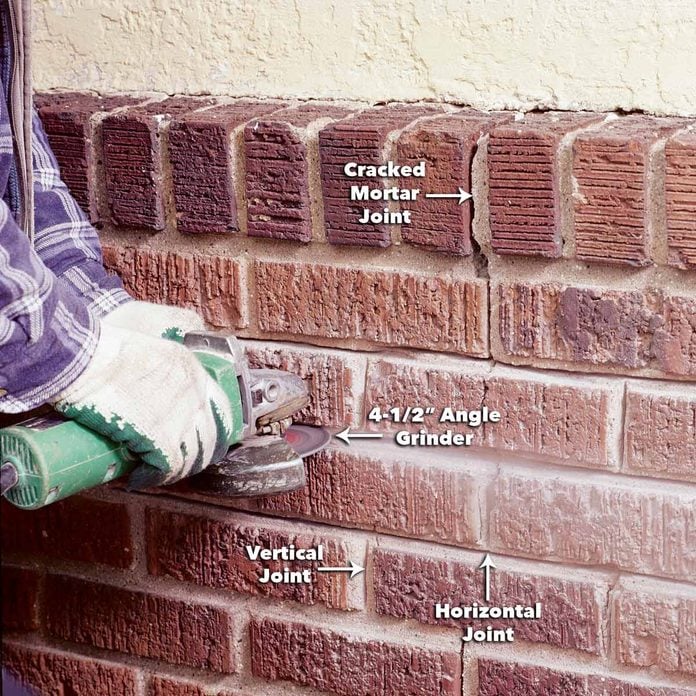
Cleaning out erstwhile mortar joints requires basic tools: hammer, flat utility chisel, safety spectacles, dust mask and whisk broom. Filling the cleaned-out joints requires masonry tools: brick trowel, three/viii-in. pointing trowel, a special tool for contouring the joints and waterproof gloves.
If yous do tackle larger jobs or meet hard mortar that can't be easily chiseled out, we recommend that you hire or buy an angle grinder fitted with a diamond blade. Select a grinder with a 4-i/2 in. bract bore; larger grinders are harder to command and cutting the mortar as well deep. To begin, Cut grooves 3/4 to ane in. deep in cracked or deteriorating mortar using a 4-i/2 in. angle grinder fitted with a diamond blade. Push the blade into the joint until the grinder head contacts the brick, and make a single pass along the heart of the joints.
Step 2
Chip Out Loose Mortar
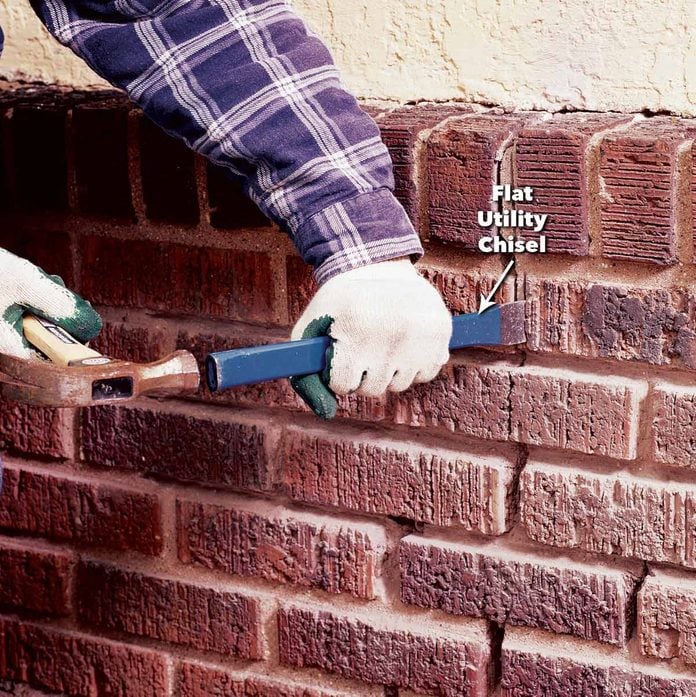
Break out one-time mortar using a hammer and common cold chisel or a flat utility chisel that'south narrow plenty to fit into the joints. Position a flat utility chisel at the edge of the brick and drive it toward the relief cut to fracture and remove the mortar. Wear rubber glasses and a dust mask and remove 3/4 to 1 in. of old mortar (more if needed) until yous attain a solid base for bonding the new mortar. If the mortar is so soft that the bricks are loosening up, you'll have to remove and properly reset them. If the cracked mortar is harder, make a relief cutting down the center of the mortar joint using the pointed edge of the chisel and then gently chip out the mortar (brick grout) that contacts the brick.
If the removal work is going really slowly, utilise an angle grinder to make the relief cuts. Practice intendance here; the grinder can easily nick and chip the bricks, so don't use information technology to clean out the mortar contacting the brick. To avoid nicking the bricks, cut the vertical joints before cutting the horizontal joints.
Step iii
Clean the Joints

Once the old mortar is removed, dust out the brick crenel joints using a whisk broom or compressed air, Set up the joints to receive new mortar by misting them lightly with a garden hose sprayer.
Stride 4
Mix the Mortar
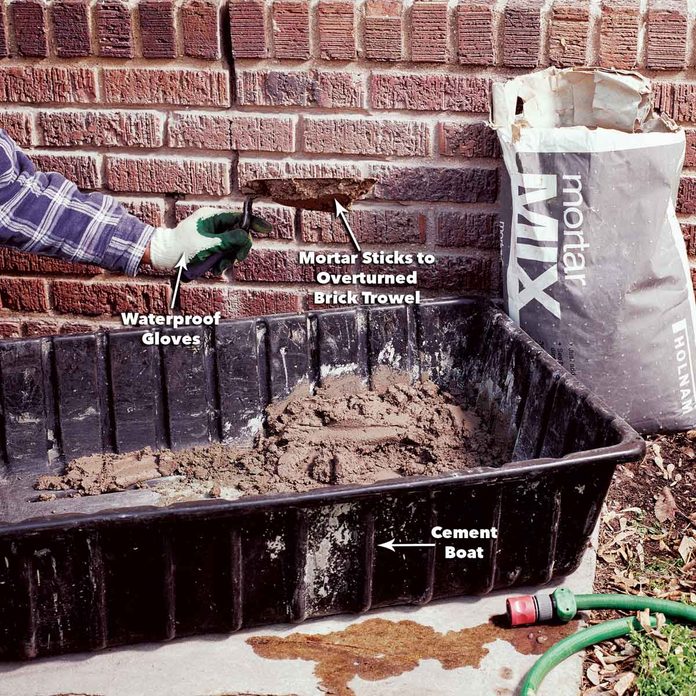
Using simply the amount of water specified past the manufacturer, gradually add together in the water and mix the mortar in a cement boat until it's the consistency of peanut butter and gluey plenty to cling to an overturned trowel. It should be stiff but non crumbly. Allow the mortar to "residual" for 10 minutes as it absorbs the water, and so remix it using your brick trowel. Don't effort to revive mortar that'due south drying out by calculation more water to it. Mix a fresh batch instead.
Step 5
Fill the Joints with Mortar
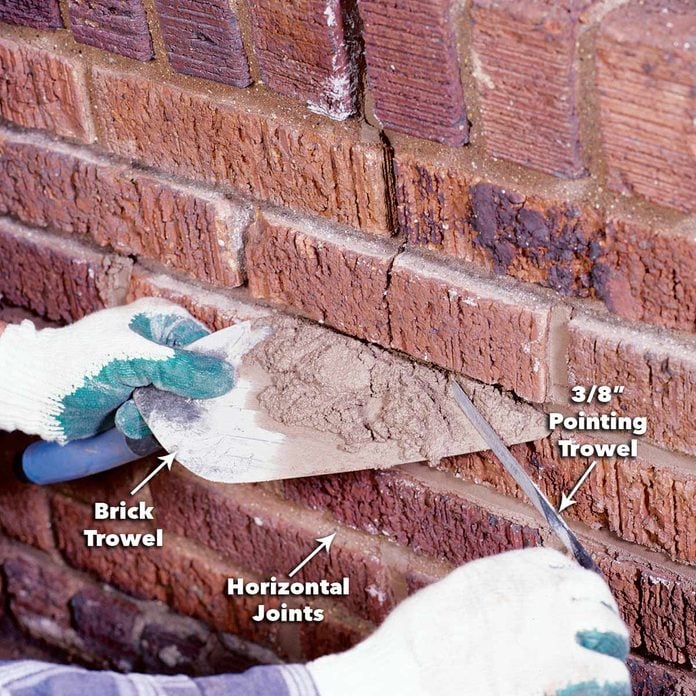
The basic steps for how to mortar brick offset like this: Load mortar onto an overturned brick trowel, hold the trowel under the horizontal joint—tight to the brick—and sweep one/iv-in. slivers of mortar into the cavity using a 3/eight-in. wide pointing trowel. Make full the horizontal joints first. Avoid getting mortar on the brick face.
Follow these boosted tips for filling mortar joints:
- Pack the mortar tightly with no voids for the strongest, most water-resistant joints.
- Fill deeper joints (those greater than iii/4 in.) in ii stages. Allow the first layer to partially harden (until a thumbprint barely leaves an indentation) before adding the second layer.
- In hot weather, work in shaded areas offset (if possible) so the sun won't dry out the mortar besides fast. Mix smaller batches of mortar.
- Don't piece of work in temperatures below 40 degrees F.
Pace half-dozen
Fill the Vertical Joints Last
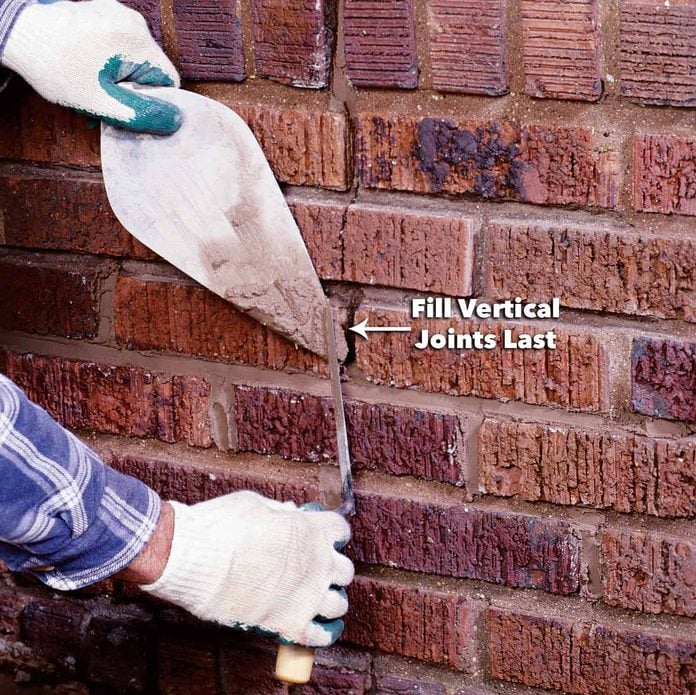
Load smaller amounts of mortar onto the back of the brick trowel, agree the trowel tip along the vertical joints and above the horizontal joints—tight to the brick—then sweep and pack the mortar into the cavity using the pointing trowel.
Step 7
Figure A: Common Mortar Joint Profiles
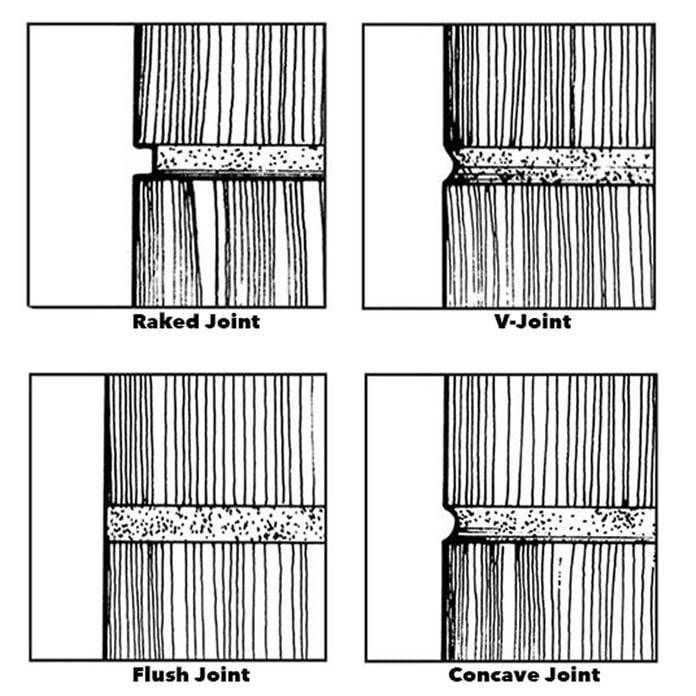
Before finishing the mortar joint, determine which articulation matches your existing joints using Figure A above. Side by side, buy the mortar finishing tool you need to match the profile and depth of your existing mortar joints. We recommend that yous repoint brick sills and other horizontal brick surfaces (ledges, wall tops, etc.) with flush joints to promote drainage—regardless of the type of mortar articulation in your vertical walls. Let the mortar to cure to "thumbprint" hardness before you finish the articulation. Shape the vertical joints before working the long horizontal joints. These are the most common mortar joint profiles:
- Raked articulation: Formed by removing mortar to 1/4 in. deep with a raking block.
- 5-Articulation: Formed by a brick jointer, it has a concave, "5" look.
- Flush joint: Formed by cutting off the mortar with the edge of a brick trowel.
- Concave joint: Formed past the curved end of a brick jointer.
Footstep 8
Rake the Joints
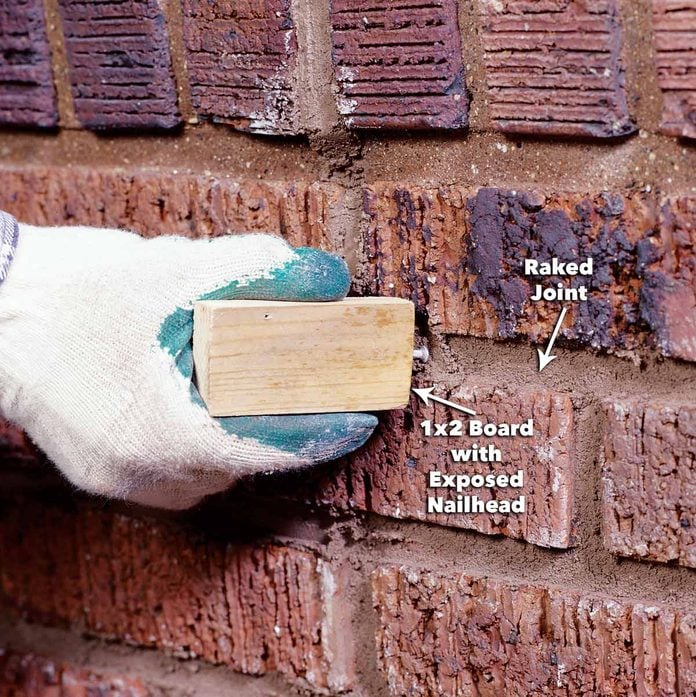
For this project, we used a raked joint mortar profile. To brand your own raked joint tool, drive a 6d box boom into a short 1x2 board so that it matches the depth of the existing joints. To "rake" joints, hold the board perpendicular to the bricks and movement it back and along, beginning along the vertical joints and then the horizontal joints. Other joint profiles require other shaping tools.
Footstep 9
Clean the Bricks
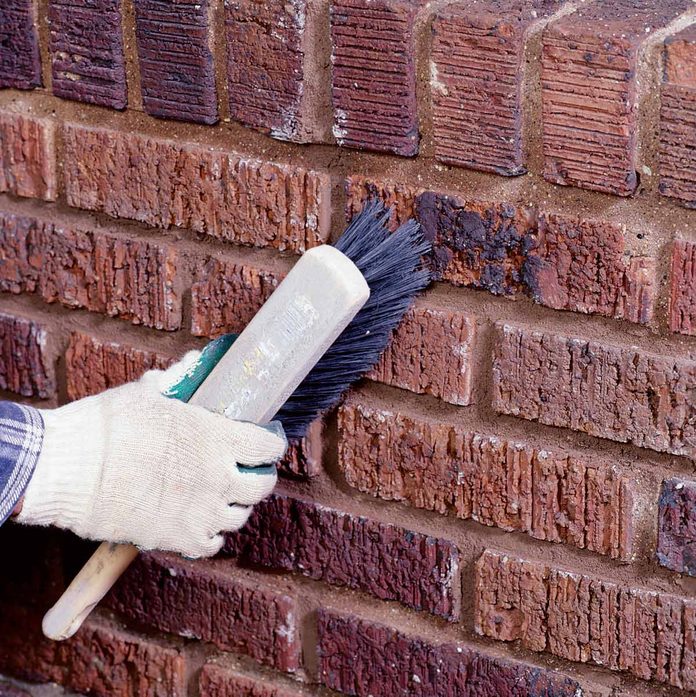
Use a soft-bristle brush to remove mortar chunks on the brick face before they harden and to sweep loose mortar from the finished joints. The brush keeps the mortar from smearing. If you do smear mortar onto the brick, you lot'll have to go dorsum subsequently and utilize a chemical cleaner. Prevent water from entering and dissentious your brickwork by applying color-matched polyurethane caulk where stucco, wood and other materials meet brick. Mist the new mortar twice a day for 2 days using a paw pump sprayer or a lite mist from a garden hose to help it harden.
Plus, check out How to Repair Broken Bricks.
Originally Published: June 26, 2022
How To Repair A 3 Foot Hole In A Brickwall On A Porch,
Source: https://www.familyhandyman.com/project/how-to-repair-mortar-joints/
Posted by: smithobby1983.blogspot.com


0 Response to "How To Repair A 3 Foot Hole In A Brickwall On A Porch"
Post a Comment